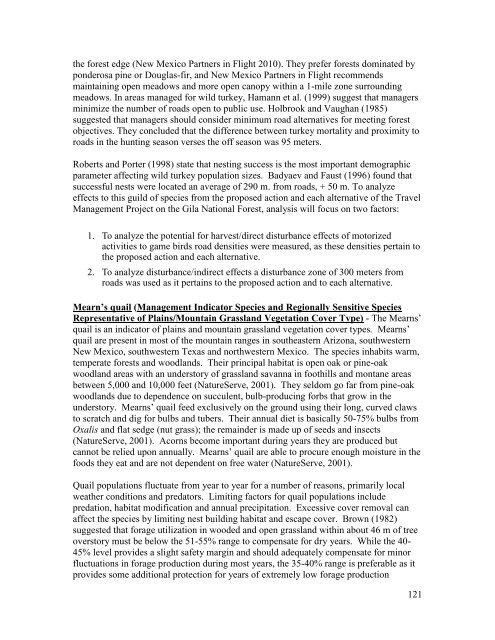Wildlife Specialist report
Wildlife Specialist report
Wildlife Specialist report
You also want an ePaper? Increase the reach of your titles
YUMPU automatically turns print PDFs into web optimized ePapers that Google loves.
the forest edge (New Mexico Partners in Flight 2010). They prefer forests dominated by<br />
ponderosa pine or Douglas-fir, and New Mexico Partners in Flight recommends<br />
maintaining open meadows and more open canopy within a 1-mile zone surrounding<br />
meadows. In areas managed for wild turkey, Hamann et al. (1999) suggest that managers<br />
minimize the number of roads open to public use. Holbrook and Vaughan (1985)<br />
suggested that managers should consider minimum road alternatives for meeting forest<br />
objectives. They concluded that the difference between turkey mortality and proximity to<br />
roads in the hunting season verses the off season was 95 meters.<br />
Roberts and Porter (1998) state that nesting success is the most important demographic<br />
parameter affecting wild turkey population sizes. Badyaev and Faust (1996) found that<br />
successful nests were located an average of 290 m. from roads, + 50 m. To analyze<br />
effects to this guild of species from the proposed action and each alternative of the Travel<br />
Management Project on the Gila National Forest, analysis will focus on two factors:<br />
1. To analyze the potential for harvest/direct disturbance effects of motorized<br />
activities to game birds road densities were measured, as these densities pertain to<br />
the proposed action and each alternative.<br />
2. To analyze disturbance/indirect effects a disturbance zone of 300 meters from<br />
roads was used as it pertains to the proposed action and to each alternative.<br />
Mearn’s quail (Management Indicator Species and Regionally Sensitive Species<br />
Representative of Plains/Mountain Grassland Vegetation Cover Type) - The Mearns’<br />
quail is an indicator of plains and mountain grassland vegetation cover types. Mearns’<br />
quail are present in most of the mountain ranges in southeastern Arizona, southwestern<br />
New Mexico, southwestern Texas and northwestern Mexico. The species inhabits warm,<br />
temperate forests and woodlands. Their principal habitat is open oak or pine-oak<br />
woodland areas with an understory of grassland savanna in foothills and montane areas<br />
between 5,000 and 10,000 feet (NatureServe, 2001). They seldom go far from pine-oak<br />
woodlands due to dependence on succulent, bulb-producing forbs that grow in the<br />
understory. Mearns’ quail feed exclusively on the ground using their long, curved claws<br />
to scratch and dig for bulbs and tubers. Their annual diet is basically 50-75% bulbs from<br />
Oxalis and flat sedge (nut grass); the remainder is made up of seeds and insects<br />
(NatureServe, 2001). Acorns become important during years they are produced but<br />
cannot be relied upon annually. Mearns’ quail are able to procure enough moisture in the<br />
foods they eat and are not dependent on free water (NatureServe, 2001).<br />
Quail populations fluctuate from year to year for a number of reasons, primarily local<br />
weather conditions and predators. Limiting factors for quail populations include<br />
predation, habitat modification and annual precipitation. Excessive cover removal can<br />
affect the species by limiting nest building habitat and escape cover. Brown (1982)<br />
suggested that forage utilization in wooded and open grassland within about 46 m of tree<br />
overstory must be below the 51-55% range to compensate for dry years. While the 40-<br />
45% level provides a slight safety margin and should adequately compensate for minor<br />
fluctuations in forage production during most years, the 35-40% range is preferable as it<br />
provides some additional protection for years of extremely low forage production<br />
121
















